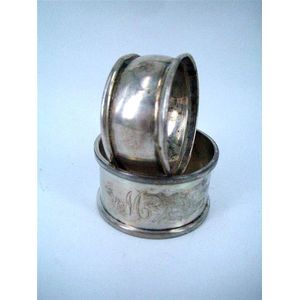George I and Queen Anne Trencher Salts
You must be a subscriber, and be logged in to view price and dealer details.
Subscribe Now to view actual auction price for this item
When you subscribe, you have the option of setting the currency in which to display prices to $Au, $US, $NZ or Stg.
- Sterling Silver - Sterling silver is a mixture of 92.5% pure silver and 7.5% of another metal, usually copper. Fine silver is 99.9% pure silver, and is relatively soft and the addition of the very small amount of copper gives the metal enough strength and hardness to be worked into jewellery, decorative and household objects.
- Quatrefoil - A stylised four-circle design, itself contained within a larger circle, with Gothic origins and often seen as window designs in ecclesiastical architecture. The use of the motif was popular in Gothic Revival furniture of the 19th century.
- Hallmarks - A mark stamped on articles of precious metals in Britain, since the 14th century, certifying their purity. It derives its name from the Guild Hall of the Goldsmiths' Company, who recieved its Charter in 1327 giving it the power to assay (test the purity) and mark articles of gold and silver.
The hallmark will consist of several marks, including the:
- silver standard mark, indicating the purity of the metal. Sterling silver is .925 pure silver.
- the city mark indicating the city in which it was assayed eg London, Birmingham, York etc.
- the date mark, usually a letter of the alphabet in a particular font and case,
- a duty mark, indicating whether duty had been paid to the crown, and only in use from 1784 to 1890
The piece may include an additional mark, the maker's mark, although not forming part of the hallmark, will be located in the vicinity of the hallmarks.
Sometimes silver plated items will bear faux hallmarks, often confusing those not familiar with silver markings. - Trencher - Originally a trencher was a wooden tray or stale piece of bread used as a plate, on which the food was placed before being eaten. A bowl of salt was placed near the trencher, and this became known as the trencher salt. Nowadays the word "trencher" is used to describe a type of salt bowl of flat open shape, usually without feet..
This item has been included into following indexes:
Visually similar items

A Continental silver acorn salt and pepper. (2)

Two Australian silver Serviette rings, Fairfax & Roberts, and Prouds. (2)

A Georg Jensen silver ring. Sterling silver, hallmarked 925 S Georg Jensen with style no 28C, designed by Georg Jensen, presented as a wide ring with polished outer edges, centred by an oxidised row of abstract triangular curved panels of domed silver

Vintage silver cuff bracelet with coral
